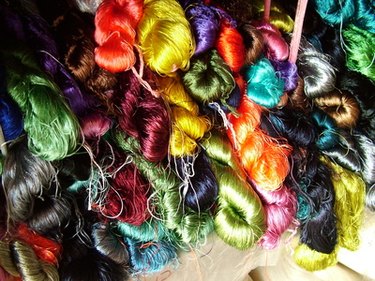Things You'll Need
Square or hexagon lap loom
Yarn or thread
Tapestry needle
Scissors

Learn how to weave on a square or hexagon lap loom to create fabric shapes. This is a simple yet versatile form of weaving which creates a fabric that resembles a waffle weave. This is a two-part process which involves wrapping and tying or knotting. Create squares or hexagons to create potholders, table mats and other small accessories, or sew several together to create an afghan. Pegged square or hexagon lap looms are simple to use and require little in the way of special equipment or knowledge. This is an ideal introduction to the craft of weaving.
How to Weave on a Lap Loom
Step 1
Use a slip knot to secure the yarn to one corner of the hexagon loom. Draw the yarn up to the peg on the opposite side of the loom and wrap the yarn around this peg in a clockwise direction. Bring the yarn down to the peg to the left of the start peg so the yarn has formed a figure of eight. Continue working in this manner until all the pegs have been wrapped.
Video of the Day
Step 2
Wrap the pegs twice more, changing the color of the yarn if required. Secure the end of the yarn by tying it around the last peg.
Step 3
Thread the tapestry needle with yarn and start to secure the yarn where it crosses to form a cross section. This is known as tying, or knotting, and involves making small stitches to hold the yarns in place. Start at the nearest cross section and bring the needle from the back to the front of the loom immediately next to where the yarn overlaps. Bring the needle across the cross section and take it to the back of the loom. Repeat this so that all of the yarn sections have been held in place before moving on to the next cross section. On a hexagon loom you will be creating a six-point star shape and on a square loom you will be creating a cross shape.
Step 4
Finish the piece by carefully removing the woven fabric from the loom by slipping the fabric over the pegs.
Tip
Achieve different effects by varying the color and texture of the yarns used. Snipping through one or two layers of yarn will create an interesting surface texture. Use thick or bulky yarn to create a more robust fabric. Crocheting squares or hexagons together to form an afghan or other large item is an alternative to sewing.
Warning
The knotting part of the process is important; it ensures that the square or hexagon maintains its shape. If the stitches are too loose the finished piece may pull out of shape.
Video of the Day